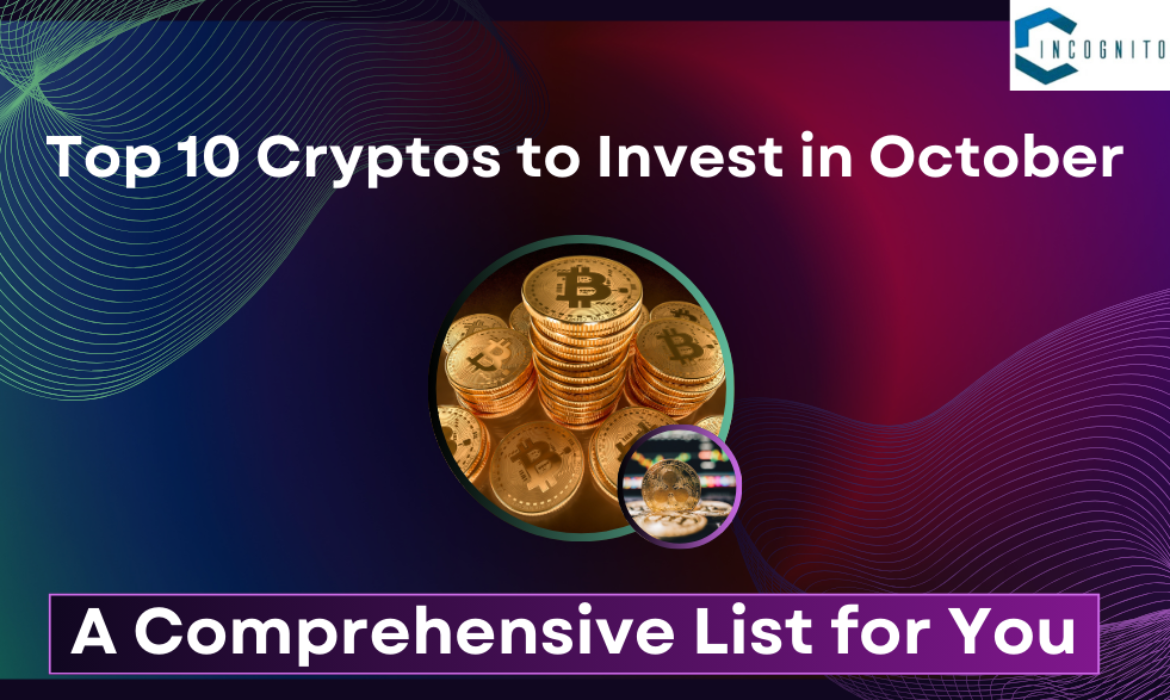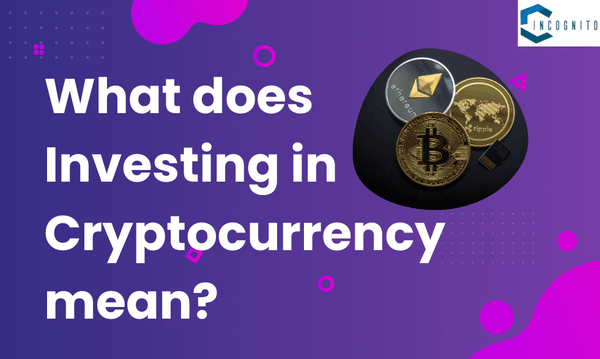
Crypto is no more an unknown thing in the market. People are now increasingly investing in it for their personal financial benefits and building portfolios.
There are many cryptos that an investor could invest in October. Among those cryptos, some are new and some have retained their dominance.
Here are the top 10 cryptos to invest this month with details such as their price, market cap, year-over-year return, pros, cons and other information.
Keep reading, keep learning!
Top 10 Cryptos to Invest in October
Alright, so below are the top 10 cryptos to invest in October. However do not forget to read the Disclaimer at the end of this article.
1. Bitcoin (BTC)
It is the largest and most recognized of today’s cryptocurrencies and even known as “digital gold” due to being one of the best hedges against traditional financial systems.
- Price: $52,000
- Market Cap: $1.01 trillion
- Year-over-Year Return: +105%
Pros:
- Highest brand recognition and highest adoption rate
- Limited supply of 21 million coins creates scarcity
Cons:
- Requires very high energy usage in mining
- Transactions are slower compared with newer cryptocurrencies
Related: How to Buy Bitcoin on eToro App
2. Ethereum (ETH)
Ethereum is a decentralized platform that enables smart contracts and dApps. It’s at the heart of many DeFi projects and NFTs.
- Price: $3,200
- Market Cap: $380 billion
- Year-over-Year Return: +85%
Pros:
- Massive dApps and DeFi ecosystem
- Transition to Ethereum 2.0 provides eventual scalability and efficiency improvements
Cons:
- Gas fees skyrocket when congestion on network occurs
- “Ethereum killers”, a potential competition may also pop up
Related: The genius behind Ethereum
3. Cardano (ADA)
Cardano is a proof-of-stake blockchain network targeted to provide greener, scalable, and more efficient alternatives to proof-of-work networks like Bitcoin.
- Price: $1.20
- Market Cap: $40 billion
- Year-over-Year Return: +30%
Pros:
- Extensive academic research and peer-reviewed development focus
- Energy-efficient proof of stake-based consensus mechanism
Cons:
- Development is slower than some of its competitors
- Fewer functional dApps on the platform
Also read: 8 Best Altcoins To Buy In October
4. Solana (SOL)
Solana is a fast performance blockchain that supports smart contracts and decentralized applications. It’s known for ultra-high speed and low fees.
- Price: $110
- Market Cap: $35 billion
- Year-over-Year Return: +200%
Pros:
- Ultra-fast transaction speeds with fees that are very low
- A growing ecosystem of DeFi and NFT projects
Cons:
- Less decentralized than some competitors
- Does have previous network outages
5. Polkadot (DOT)
Polkadot is a multi-chain network designed to allow several blockchains to work together yet remain fully decentralized and private in web development.
- Price: $28
- Market Cap: $30 billion
- Year-over-Year Return: +45%
Pros:
- Interoperability between various blockchains
- Parallel processing which ensures high scalability
Cons:
- Complex technology which may be difficult to understand for the average user
- Still in development with some of the features yet to be implemented.
Also read: Top Crypto Subreddits to Follow
6. Chainlink (LINK)
Chainlink is the decentralized oracle network providing actual data to blockchain-based smart contracts for more complex and useful applications.
- Price: $25
- Market Cap: $12 billion
- Year-over-Year Return: +20%
Pros:
- The essential infrastructure for most DeFi applications
- Partnerships with major companies and institutions
Cons:
- Potential competition from other oracle solutions
- Token value doesn’t always correlate with network usage
7. Uniswap (UNI)
Uniswap is a decentralized exchange protocol that is built on Ethereum. It allows users a way of trading cryptocurrencies without using an intermediary and provides liquidity to the DeFi ecosystem.
- Price: $22
- Market Cap: $11 billion
- Year-over-Year Return: +70%
Pros:
- It is a leading decentralized exchange by volume
- Always innovating with new versions and more features
Cons:
- Dependent on Ethereum network, which sometimes means high gas fees.
- Growing competition from other DEXs
8. Avalanche (AVAX)
Avalanche is a layer-one blockchain set up to host decentralized applications and custom blockchain networks. It is built for high-speed processes, low costs, and eco-friendliness.
- Price: $65
- Market Cap: $15 billion
- Year-over-Year Return: +250%
Pros:
- High finality and throughput
- Increasing ecosystem of DeFi and NFT projects
Cons:
- Young project with less proven track record
- Stiff competition in the layer-one blockchain space
9. Polygon (MATIC)
Polygon is a layer-two scaling solution for Ethereum, aiming to provide more efficient and lower-cost transactions on the Ethereum network.
- Price: $1.50
- Market Cap: $10 billion
- Year-over-Year Return: +180%
Pros:
- Massive decrease in transaction fees for Ethereum-based applications
- Strong partnerships and growing ecosystem
Cons:
- Tied into Ethereum’s success and adoption
- Could face competition from other layer-two solutions
10. Algorand (ALGO)
Algorand blockchain is trying to achieve something which can be referred to as scalable, secure, and decentralized. Its pure proof-of-stake consensus mechanism focuses entirely on the solution of the blockchain trilemma.
- Price: $1.80
- Market Cap: $8 billion
- Year-over-Year Return: +140%
Pros:
- It is fast, secure, and scalable blockchain
- Strong focus on sustainability and carbon-negative operations
Cons:
- Not as much name recognition as the larger cryptocurrencies
- There are not as many dApps or projects on the platform compared to some other competitors

What does Investing in Cryptocurrency mean?
What does Investing in Cryptocurrency mean?
To invest in cryptocurrency means is to put your money into some digital or virtual currencies by the hope that value will rise after some time and you can sell them at higher values for profit.
In simple words, here are more clarifications:
1. Digital Assets:
Cryptocurrencies are virtual assets created with cryptography. They are not physical coins and notes but rather digital entries in a distributed ledger called a blockchain.
2. Purchasing:
You buy the cryptocurrencies utilizing some ‘traditional’ money like USD or EUR via cryptocurrency exchanges or brokers.
3. Storage:
Once you have purchased them, you put those kept cryptocurrencies inside electronic wallets, which can either be Online (hot wallets) or Offline (cold wallets).
4. Volatility:
The prices of cryptocurrencies are rather volatile and susceptible to sudden swings in market demand, technological enhancement, changes in regulation etc.
5. Returns Potential:
Investors invest with the hope of making some profit from price appreciation. Although a few cryptocurrencies have increased exponentially, they can also decline enormously.
6. Use Cases:
Apart from speculation, some investors do believe in the technology and future use of cryptocurrencies, such as decentralized finance (DeFi) applications.
7. Risks:
Cryptocurrency investing is pretty much about high risk due to volatility, regulatory uncertainties, and the evolving nature of the technology.
8. Diversification:
There are investors who buy them to diversify their investment portfolios.
9. Research:
Successful crypto investing most of the times involves knowledge of the technology, market trends, and the actual projects you are investing in.
Conclusion
The cryptocurrency market is super volatile. Past results are not a guarantee for future results. Investing in cryptocurrency comes with huge risks. It is not suitable for everyone.
Therefore, it is important to invest only the amount you can afford to lose and what you have studied about the process of investment in a particular asset.
Disclaimer: This article is for information purposes only and should not be viewed or considered as financial advice. Cryptocurrency investments involve extreme volatilities and risks. Always do your own research before getting into investments.




